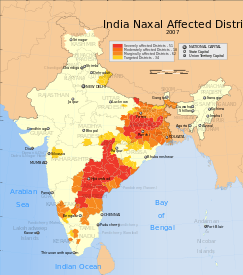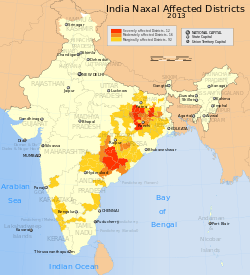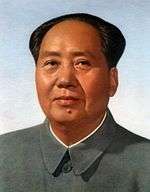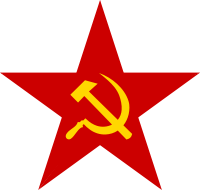Naxalite


| Part of a series on |
| Maoism |
|---|
 |
|
A Naxal or Naxalite is a member of any of the Communist guerrilla groups in India, mostly associated with the Communist Party of India (Maoist). The term Naxal derives from the name of the village Naxalbari in West Bengal, where the movement had its origin. Naxalites are considered far-left radical communists, supportive of Maoist political sentiment and ideology. Their origin can be traced to the split in 1967 of the Communist Party of India (Marxist), leading to the formation of the Communist Party of India (Marxist–Leninist). Initially the movement had its centre in West Bengal. In later years, it spread into less developed areas of rural southern and eastern India, such as Chhattisgarh, Odisha, Andhra Pradesh and Telangana through the activities of underground groups like the Communist Party of India (Maoist).[1]
In 2006 India's intelligence agency, the Research and Analysis Wing, estimated that 20,000 armed-cadre Naxalites were operating in addition to 50,000 regular cadres.[2] Their growing influence prompted Indian Prime Minister Manmohan Singh to declare them to be the most serious internal threat to India's national security.[3] Naxalites, and other anti-government militants, are often referred to as "ultras".[4]
In February 2009, the Indian Central government announced a new nationwide initiative, to be called the "Integrated Action Plan" (IAP) for broad, co-ordinated operations aimed at dealing with the Naxalite problem in all affected states (namely Karnataka, Chhattisgarh, Odisha, Andhra Pradesh, Telangana, Maharashtra, Jharkhand, Bihar, Uttar Pradesh, and West Bengal). Importantly, this plan included funding for grass-roots economic development projects in Naxalite-affected areas, as well as increased special police funding for better containment and reduction of Naxalite influence in these areas.[5][6]
In 2009, Naxalites were active across approximately 180 districts in ten states of India.[7] In August 2010, after the first full year of implementation of the national IAP program, Karnataka was removed from the list of Naxalite-affected states.[8] In July 2011, the number of Naxalite-affected areas was reduced to 83 districts in nine states (including 20 additional districts).[9][10][11] In December 2011, the national government reported that the number of Naxalite-related deaths and injuries nationwide had gone down by nearly 50% from 2010 levels.[12] Maoist communist groups claimed responsibility for 192 deaths in 2013, which was nearly half of all deaths from terrorism in India.[13]
History
The term Naxalites comes from Naxalbari, a small village in West Bengal, where a section of the Communist Party of India (Marxist) (CPI-M) led by Charu Majumdar, Kanu Sanyal, and Jangal Santhal initiated a violent uprising in 1967. On 18 May 1967, the Siliguri Kishan Sabha, of which Jangal was the president, declared their support for the movement initiated by Kanu Sanyal, and their readiness to adopt armed struggle to redistribute land to the landless.[14] The following week, a sharecropper near Naxalbari village was attacked by the landlord's men over a land dispute. On 24 May, when a police team arrived to arrest the peasant leaders, it was ambushed by a group of tribals led by Jangal Santhal, and a police inspector was killed in a hail of arrows. This event encouraged many Santhal tribals and other poor people to join the movement and to start attacking local landlords.[15]
These conflicts go back to the failure to implement the 5th and 6th Schedules of the Constitution of India.[16] In theory these Schedules provide for a limited form of tribal autonomy with regard to exploiting natural resources on their lands, e.g. pharmaceutical and mining, and 'land ceiling laws', limiting the land to be possessed by landlords and distribution of excess land to landless farmers and labourers.
Mao Zedong provided ideological leadership for the Naxalbari movement, advocating that Indian peasants and lower class tribals overthrow the government and upper classes by force. A large number of urban elites were also attracted to the ideology, which spread through Charu Majumdar's writings, particularly the 'Historic Eight Documents' which formed the basis of Naxalite ideology.[17]
At the time, the leaders of this revolt were members of the CPI (M), which joined a coalition government in West Bengal just a few months back. Leaders like land minister Hare Krishna Konar had been until recently "trumpeting revolutionary rhetoric, suggesting that militant confiscation of land was integral to the party's programme."[18] However, now that they were in power, CPI (M) did not approve of the armed uprising, and all the leaders and a number of Calcutta sympathizers were expelled from the party.
Subsequently, In November 1967, this group, led by Sushital Ray Chowdhury, organized the All India Coordination Committee of Communist Revolutionaries (AICCCR).[19] Violent uprisings were organized in several parts of the country. On 22 April 1969 (Lenin's birthday), the AICCCR gave birth to the Communist Party of India (Marxist-Leninist) (CPI (ML)).
Practically all Naxalite groups trace their origin to the CPI (ML). A separate offshoot from the beginning was the Maoist Communist Centre, which evolved out of the Dakshin Desh group. The MCC later fused with the People's War Group to form the Communist Party of India (Maoist). A third offshoot was that of the Andhra revolutionary communists, mainly represented by the UCCRI(ML), following the mass line legacy of T. Nagi Reddy, which broke with the AICCCR at an early stage.
During the 1970s, the movement was fragmented into disputing factions. By 1980, it was estimated that around 30 Naxalite groups were active, with a combined membership of 30,000.[20]
Violence in West Bengal
Around 1971 the Naxalites gained a strong presence among the radical sections of the student movement in Calcutta.[21] Students left school to join the Naxalites. Majumdar, to entice more students into his organisation, declared that revolutionary warfare was to take place not only in the rural areas as before, but everywhere and spontaneously. Thus Majumdar declared an "annihilation line", a dictum that Naxalites should assassinate individual "class enemies" (such as landlords, businessmen, university teachers, police officers, politicians of the right and left) and others.[22][23]
The chief minister, Siddhartha Shankar Ray of the Congress Party, instituted strong counter-measures against the Naxalites. The West Bengal police fought back to stop the Naxalites. The house of Somen Mitra, the Congress MLA of Sealdah, was allegedly turned into a torture chamber where Naxals were incarcerated illegally by police and the Congress cadres. CPI-M cadres were also involved in the "state terror". After suffering losses and facing the public rejection of Majumdar's "annihilation line", the Naxalites alleged human rights violations by the West Bengal police, who responded that the state was effectively fighting a civil war and that democratic pleasantries had no place in a war, especially when the opponent did not fight within the norms of democracy and civility.[15]
Large sections of the Naxal movement began to question Majumdar's leadership. In 1971 the CPI(ML) was split, as the Satyanarayan Singh revolted against Majumdar's leadership. In 1972 Majumdar was arrested by the police and died in Alipore Jail. His death accelerated the fragmentation of the movement.
Operation Steeplechase
In July 1971, Indira Gandhi took advantage of President's rule to mobilise the Indian Army against the Naxalites and launched a colossal combined army and police counter-insurgency operation, termed "Operation Steeplechase," killing hundreds of Naxalites and imprisoning more than 20,000 suspects and cadres, including senior leaders.[24] The paramilitary forces and a brigade of para commandos also participated in Operation Steeplechase. The operation was choreographed in October 1969, and Lt. General J.F.R. Jacob was enjoined by Govind Narain, the Home Secretary of India, that "there should be no publicity and no records" and Jacob's request to receive the orders in writing was also denied by Sam Manekshaw.[25]
2000–present
In a 2004 Indian Home Ministry estimate, their numbers were placed at that time at "9,300 hardcore underground cadre ... [holding] around 6,500 regular weapons beside a large number of unlicensed country-made arms".[26] In 2006, according to Judith Vidal-Hall, "Figures (in that year) put the strength of the movement at 15,000, and claim the guerrillas control an estimated one fifth of India's forests, as well as being active in 160 of the country's 604 administrative districts."[27] India's Research and Analysis Wing believed in 2006 that 20,000 Naxals were involved in the growing insurgency.[2]
Today, some Naxalite groups have become legal organisations participating in parliamentary elections, such as the Communist Party of India (Marxist-Leninist) Liberation, the Communist Party of India (Maoist) and the Communist Party of India (Marxist-Leninist) Janashakti.
2010
- 6 April: Naxalites launched the most deadly assault in the history of the Naxalite movement by killing 76 security personnel. The attack was launched by up to 1,000 Naxalites[28][29] in a well-planned attack, killing an estimated 76 CRPF personnel in two separate ambushes and wounding 50 others, in the remote jungles of Chhattisgarh's Dantewada district in Eastern/Central India.
- 17 May, Naxals blew up a bus on Dantewda–Sukhma road in Chhattisgarh, killing 15 policemen and 20 civilians. In the third major attack by Naxals on 29 June, at least 26 personnel of the CRPF were killed in Narayanpur district of Chhattisgarh.
Despite the 2010 Chhattisgarh ambushes, the most recent central government campaign to contain and reduce the militant Naxalite presence appears to be having some success.[12] States such as Madhya Pradesh have reported significant reduction in Naxalite activities as a result of their use of IAP funds for rural development within their states.[30] The recent success in containing violence may be due to a combination of more state presence, but also due to the recent introduction of social security schemes, such as NREGA.[31]
2011
- Late 2011:, Kishenji, the military leader of Communist Party of India (Maoist), was killed in an encounter with the joint operation forces, which was a huge blow to the Naxalite movement in eastern India.[32]
- March: Maoist rebels kidnapped two Italians in the eastern Indian state of Odisha, the first time Westerners were abducted there.[33]
- 27 March: 12 CRPF personnel were killed on in a landmine blast triggered by suspected Naxalites in Gadchiroli district of Maharashtra.[34]
2013
- 25 May 2013, Naxalites attacked a rally led by the Indian National Congress in Sukma village in Bastar Chhattisgarh, killing about 29 people. They killed senior party leader Mahendra Karma and Nand Kumar Patel and his son while in the attack another senior party leader Vidya Charan Shukla was severely wounded and later succumbed to death due to his injuries
- 11 June. See: 2013 Maoist attack in Darbha Valley.[35]
2014
- 11 March 2014, Naxalites in Chhattisgarh ambushed a security team, killing 15 personnel, 11 of whom were from the CRPF. A civilian was also killed.[36]
- 1 December 2014 Monday killed 14 CRPF personnel and 12 injured in south Chhattisgarh's Sukma district [37]
2015
- 11 April 2015 : 7 Special Task Force (STF) personals were killed in a Maoist ambush near Kankerlanka, Sukma, *Chhattisgarh.[74]
- 12 April 2015 : 1 BSF Jawan was killed in a Maoist attack near Bande, Kanker, Chhattisgarh.[75]
- 13 April 2015 : 5 Chhattisgarh Armed Force (CAF) Jawans were killed in a Maoist ambush near Kirandul, Dantewada, Chhattisgarh.[76]
2016
- 24 October 2016 : 24 Naxalites were killed by Andhra Pradesh Greyhounds forces in encounter that took place in the cut-off area of remote Chitrakonda on Andhra-Odisha border.[38]
- In November, 2016, three naxalites were killed near Karulai in an encounter with Kerala police. Naxalite leader Kappu Devaraj from Andhra Pradesh is included in the list of killed in the incident.[39]
In popular culture
Satyajit Ray's 1971 film Seemabaddha was based on the life of an upper class family during the Naxalite Movement. Erra Cinema is a popular coinage in the south Indian language of Telugu referring to a collection of films many of which featured narratives in which a representation of Naxals and Maoists is attempted.
CHORUS (1974 or 75) a film by the renowned director Mrinal Sen is a paen to the beloved 30000 (supposedly the number of naxalites killed by the government). It was made around the time of the Emergency in India and Mrinal Sen had to adopt a very experimental - almost allegorical - style to beat the censors.
Khwaja Ahmad Abbas made a critically acclaimed film The Naxalites in 1980. It starred Mithun Chakraborty in the lead.
The British musical group Asian Dub Foundation have a song called "Naxalite", which is featured on the soundtrack to the 1999 film Brokedown Palace.
The 2002 Bollywood movie Lal Salaam directed by Gaganvihari Borate starring Nandita Das revolves around Naxalism and a group of Naxalites.
The 2005 Bollywood movie Tango Charlie directed by Mani Shankar featuring Ajay Devgan had instances of the Naxalite movement and armed forces' counter operations.
A 2005 movie called Hazaaron Khwaishein Aisi, directed by Sudhir Mishra, was set against the backdrop of the Naxalite movement.
In August 2008, Kabeer Kaushik's Chamku, starring Bobby Deol and Priyanka Chopra, explored the story of a boy who is brainwashed to take arms against the state.
In the novel English August by Upamanyu Chatterjee, there is reference to Naxal cadres whom the main protagonist, an IAS officer meets while visiting a tribal village in mid-1980s.
In the novel The God of Small Things by Arundhati Roy, there is a reference to a character joining the Naxalites.
In the novel The White Tiger by Aravind Adiga, the Naxals (sic) are mentioned often by the poor and the rich alike.
In the novel A Fine Balance by Rohinton Mistry, the character Omprakash makes an allusion to fighting "like the Naxalites" (195).
In the 2012 novel The Truth by Michael Palin the protagonist Mabbutt is kidnapped by Naxalites who are protecting his subject, Hamish Melville.
The 2012 science-fiction novel Intrusion by Ken MacLeod features a future version of the Naxalites in the role of a controversial terrorist group.
In the Indian novel Red Jihad: Battle for South Asia by Sami A. Khan, a splinter Naxalite faction (led by Comrade Agyaat) join hands with a Jihadi-cell (under Yasser Basheer) to destabilize a secular, democratic South Asia.[40]
The 2013 novel The Lowland by Jhumpa Lahiri has one of the main characters involved in the Naxalite rebellion.
In 1974 Ramon Magsaysay Award winner Mahasweta Devi wrote Hajar Churashir Maa (Mother of 1084),[41] giving an ideological and sympathetic support to the Naxalites.[42] It was made into a film titled Hazaar Chaurasi Ki Maa in 1998. It starred Jaya Bachchan as the mother of 1084, who was leader killed by the state.
The 2009 Malayalam movie Thalappavu portrays the story of Naxal Varghese, who was allegedly shot dead by the police during the 70s.
In the Kannada movie Veerappa Nayaka, Vishnuvardhan portrays a Gandhian whose son becomes a Naxalite.
The 2007 Kannada movie Maathaad Maathaadu Mallige again sees Vishnuvardhan as a Gandhian who confronts a Naxalite Sudeep and shows him that the ways adopted by Naxals will only lead to violence and will not achieve their objective.
Eka Nakshalwadya Cha Janma (Marathi: The birth of a Naxal), a novel written by Vilas Balkrishna Manohar, a volunteer with the Lok Biradari Prakalp, is a fictional account of a Madia Gond Juru's unwilling journey of life with his metamorphosis from an exploited nameless tribal to a Naxal.[43]
In 2010, a Hindi drama movie Red Alert: The War Within was released that is based on the true story of a poor Andhra cook who gets caught in the gunfire between cops and Naxalites and is forced to work with the latter.
In the 2011 Tamil political thriller film Ko, Naxalites are shown to rob a bank, overthrow the government and disrupt elections. At the end, it is shown that the naxalites were only used for political gains by corrupt politicians.
Sindhooram, a National Award winning Telugu film released in 1997, portrays a young police officer becoming a naxalite under unavoidable circumstances. Directed by Krishna Vamsi, the movie was critically acclaimed for its direction and the performances of its lead actors.
Swayamsiddha (Oriya: ସୟଂସିଧ୍ଧା) is a 2010 Oriya film directed by Sudhanshu Mohan Sahu which focuses on how and why people take to extremism, but overall is a balanced movie and has messages for both the extremists and the government. The movie faced controversy as the main actor of the film, Siddhanta Mahapatra, an M.P. belonging to the ruling party Biju Janata Dal of Odisha, portrays a Maoist leader in the film. The opposition parties in the state went on strikes and demanded ban on release of the film.
Chakravyuh, a film by Prakash Jha, was released in 2012. It revolves around the theme of Naxalites, but received critical feedback for allegedly showing sympathy for Maoists.
Red Ant Dream, a documentary by Sanjay Kak, is based on the revolutionary Maoist movement in India. This documentary was under production for more than three years and released in 2013.[44]
In his book named Hello Bastar (ISBN 978-93-80658-34-6), writer Rahul Pandita has provided insights about the advent of Naxalism in Bastar district of Chhattisgarh and day to day life of Naxalites in the dense forests of this district.
Sudeep Chakravarti in his book Red Sun talks about various factors that have led to Naxalite Movement. The book is a travelogue through the Naxalite country, wherein he meets different people around the Naxalite Movement and comments upon its causes and influences.
The Lives of Others (novel), a novel by Neel Mukherjee, published in 2014 and shortlisted for the 2014 Man Booker Prize, includes a major plot thread on the lives of Naxalites, the social depredations which they attack and police torture of suspects.
See also
References
- ↑ Ramakrishnan, Venkitesh (21 September 2005). "The Naxalite Challenge". Frontline Magazine (The Hindu). Retrieved 2007-03-15.
- 1 2 Philip Bowring (18 April 2006). "Maoists who menace India". International Herald Tribune. Retrieved 2009-03-17.
- ↑ "South Asia | Senior Maoist 'arrested' in India". BBC News. 19 December 2007. Archived from the original on 20 December 2007.
- ↑ Press Trust of India (PTI) (25 March 2006). "Naxals attack Orissa jail, free prisoners, kill 3 cops". Indian Express. Archived from the original on 7 January 2014.
- ↑ "Special project for Naxal areas to be extended to 18 more districts". The Times Of India. 8 December 2011. Retrieved 2012-01-02. Times of India describes some details of ongoing nationwide Naxalite containment program, its "Integrated Action Plan".
- ↑ Co-ordinated operations to flush out Naxalites soon The Economic Times, 6 February 2009.
- ↑ Handoo, Ashok. "Naxal Problem needs a holistic approach". Press Information Bureau. Retrieved 2009-08-08.
- ↑ "Karnataka no longer Naxal infested". The Times Of India. 26 August 2010.
- ↑ Chhibber, Maneesh (5 June 2011). "Centre to declare more districts Naxal-hit". Indian Express. Archived from the original on 7 January 2013.
- ↑ Ministry of Panchayati Raj (14 January 2011). "Sixty Tribal and Backward districts in 9 states to get Central Grant under IAP". Press Information Bureau, Government of India. Archived from the original on 5 September 2012.
- ↑ "Development plan for Naxal-hit districts shows good response". The Times Of India. 23 June 2011.
- 1 2 "'Historic low' in terror, Naxal violence". 31 December 2012. Retrieved 2012-12-31.
- ↑ "Terror activities rise in India by 70 per cent: Global Index". India News Analysis Opinions on Niti Central.
- ↑ Sen, Sunil Kumar (1982). Peasant movements in India: mid-nineteenth and twentieth centuries. Calcutta: K.P. Bagchi.
- 1 2 Diwanji, A. K. (2 October 2003). "Primer: Who are the Naxalites?". Rediff.com. Retrieved 2007-03-15.
- ↑ See Outlook India comment by E.N. Rammohan 'Unleash the Good Force' - edition 16 July 2012.
- ↑ "History of Naxalism". Hindustan Times. 15 December 2005. Archived from the original on 8 February 2011.
- ↑ Atul Kohli (1998). From breakdown to order: West Bengal, in Partha Chatterjee, State and politics in India. OUP. ISBN 0-19-564765-3.p. 348
- ↑ Mukherjee, Arun (2007). Maoist "spring thunder": the Naxalite movement 1967–1972. K.P. Bagchi & Co., Calcutta. ISBN 81-7074-303-6.p.295
- ↑ Singh, Prakash. The Naxalite Movement in India. New Delhi: Rupa & Co., 1999. p. 101.
- ↑ Judith Vidal-Hall, "Naxalites", p. 73–75 in Index on Censorship, Volume 35, Number 4 (2006). p. 73.
- ↑ Sen, Antara Dev (25 March 2010). "A true leader of the unwashed masses". DNA (Diligent Media Corporation). Mumbai, India. Archived from the original on 7 January 2014.
- ↑ Dasgupta, Biplab (1973). "Naxalite Armed Struggles and the Annihilation Campaign in Rural Areas" (PDF). Economic and Political Weekly. 1973: 173–188. Archived from the original (PDF) on 27 November 2011.
- ↑ Lawoti, Mahendra; Pahari, Anup Kumar (2009). "Part V: Military and state dimension". The Maoist Insurgency in Nepal: Revolution in the Twenty-first Century. London: Routledge. p. 208. ISBN 978-1-135-26168-9.
The second turning point came in the wake of the 1971 Bangladesh war of independence which India supported with armed troops. With large contingents of Indian Army troops amassed in the West Bengal border with what was then East Pakistan, the Government of Indira Gandhi used the opening provided by President's Rule to divert sections of the army to assist the police in decisive counter–insurgency drives across Naxal–impacted areas. "Operation Steeplechase," a police and army joint anti–Naxalite undertaking, was launched in July–August 1971. By the end of "Operation Steeplechase" over 20,000 suspected Naxalites were imprisoned and including senior leaders and cadre, and hundreds had been killed in police encounters. It was a massive counter–insurgency undertaking by any standards.
- ↑ Pandita, Rahul (2011). Hello, Bastar : The Untold Story of India's Maoist Movement. Chennai: Westland (Tranquebar Press). pp. 23–24. ISBN 978-93-80658-34-6. OCLC 754482226.
Meanwhile, the Congress government led by Indira Gandhi decided to send in the army and tackle the problem militarily. A combined operation called Operation Steeplechase was launched jointly by military, paramilitary and state police forces in West Bengal, Bihar and Orissa.
In Kolkata, Lt General J.F.R. Jacob of the Indian Army's Eastern Command received two very important visitors in his office in October 1969. One was the army chief General Sam Manekshaw and the other was the home secretary Govind Narain. Jacob was told of the Centre's plan to send in the army to break the Naxal. More than 40 years later, Jacob would recall how he had asked for more troops, some of which he got along with a brigade of para commandos. When he asked his boss to give him something in writing, Manekshaw declined, saying, 'Nothing in writing.' while secretary Narain added that there should be no publicity and no records. - ↑ Quoted in Judith Vidal-Hall, "Naxalites", p. 73–75 in Index on Censorship, Volume 35, Number 4 (2006). p. 74.
- ↑ Judith Vidal-Hall, "Naxalites", p. 73–75 in Index on Censorship, Volume 35, Number 4 (2006). p. 74.
- ↑ "Indian police killed by Maoists". Al Jazeera. 6 April 2010. Archived from the original on 16 September 2012.
- ↑ "76 security men killed by Naxals in Chhattisgarh". Ndtv.com. 6 April 2010. Archived from the original on 9 April 2010.
- ↑ "MP govt claims positive change in Naxal-hit areas". 2011. Retrieved 2011-01-02.
- ↑ Fetzer, Thiemo (18 October 2013). "Can Workfare Programs Moderate Violence? Evidence from India." (PDF). Archived (PDF) from the original on 19 November 2013. Abstract
- ↑ Reddy, K. Srinivas (25 November 2011). "Kishenji's death a serious blow to Maoist movement". The Hindu. Chennai, India.
- ↑ "India Maoists kidnap Italian tourists in Orissa". BBC News. 18 March 2012.
- ↑ "12 CRPF jawans killed in Gadchiroli Naxal ambush". The Hindu. Chennai, India. 27 March 2012.
- ↑ "Naxalite attack: 2 Congress leaders massacred, Rahul Gandhi reaches Chhattisgarh". Dainik Bhaskar. Retrieved 26 May 2013.
- ↑ Suvojit Bagchi. "Maoists kill 15 in Chhattisgarh". The Hindu.
- ↑ "Deadly Naxal attack in Chhattisgarh; 14 CRPF troopers dead, 12 injured". Zee News.
- ↑ "24 Maoists killed in encounter on Andhra-Odisha border - Times of India". The Times of India. Retrieved 2016-10-30.
- ↑ http://www.mathrubhumi.com/news/kerala/nilambur-maoist-malayalam-news-1.1529750
- ↑ Khan, Sami Ahmad (2012). Red Jihad: Battle for South Asia. New Delhi: Rupa Publication. ISBN 978-81-291-1987-2.
- ↑ "Mother of 1084" - the number assigned to her son in the morgue.
- ↑ 'Through her writing, you get to hear the voice of a community that is otherwise voiceless' rediff.com. Retrieved 19 October 2012
- ↑ Who's who of Indian Writers, 1999 By K. C. Dutt, Sahitya Akademi. Books.google.com. Retrieved 2009-03-17.
- ↑ "A Long March". The Caravan - A Journal of Politics and Culture.
Further reading
- Naxalite Politics in India, by J. C. Johari, Institute of Constitutional and Parliamentary Studies, New Delhi, . Published by Research Publications, 1972.
- The Naxalite Movement, by Biplab Dasgupta. Published by , 1974.
- The Naxalite Movement: A Maoist Experiment, by Sankar Ghosh. Published by Firma K.L. Mukhopadhyay, 1975. ISBN 0-88386-568-8.
- The Naxalite Movement in India: Origin and Failure of the Maoist Revolutionary Strategy in West Bengal, 1967–1971, by Sohail Jawaid. Published by Associated Pub. House, 1979.
- In the Wake of Naxalbari: A History of the Naxalite Movement in India, by Sumanta Banerjee. Published by Subarnarekha, 1980.
- Edward Duyker Tribal Guerrillas: The Santals of West Bengal and the Naxalite Movement, Oxford University Press, New Delhi, 1987, p. 201, SBN 19 561938 2
- The Naxalite Movement in India, by Prakash Singh. Published by Rupa, 1995. ISBN 81-7167-294-9.
- V. R. Raghavan ed. The Naxal Threat : Causes, State Responses and Consequences, Publisher Vij Books India Pvt Ltd, ISBN 978-93-80177-77-9
- Mary Tyler (1977). My Years in an Indian Prison. London: Victor Gollancz Ltd. OCLC 3273743.
External links
| Wikimedia Commons has media related to Naxalite. |
- Status Paper on the Naxalite problem - South Asia Terrorism Portal
- West Bengal, districts affected by Naxalite violence - South Asia Terrorism Portal
- "Walking With The Comrades" An extensive 32 page essay by Arundhati Roy on her interactions with naxalites
- Articles and Research Reports on Naxalite Violence in India and Pakistan
- "History of Naxalism". Hindustan Times. 15 December 2005. Archived from the original on 8 February 2011.

